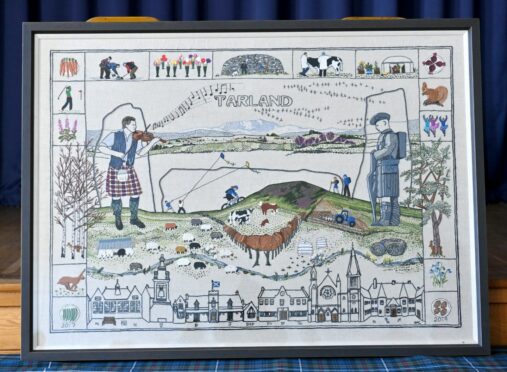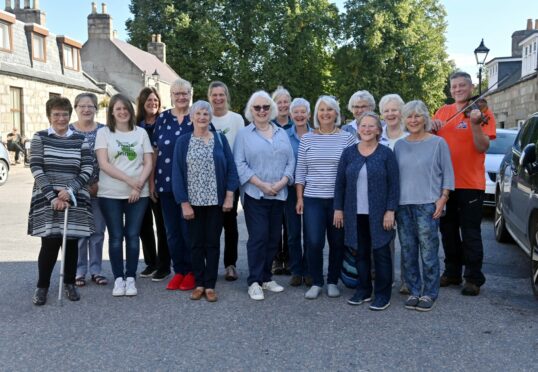It has taken thousands of hours of work by hundreds of stitchers – anchored by a group of little more than a dozen locals – but the Tarland Tapestry has finally been unveiled to the public in its permanent home.
The artwork has been around seven years in the making, with the idea of a collaborative piece celebrating the Deeside village and the surrounding Howe of Cromar first conceived when the Great Tapestry of Scotland was on display at Aberdeen Art Gallery in 2014.
That seed was slow to germinate, but a team of 15 Tarland residents – none of whom had been seriously involved in embroidery of any kind beforehand – began work in 2017.
Among them was Jan Healey, who joined the group on a visit to East Lothian to discuss plans with the Great Tapestry‘s lead artist Andrew Crummy and stitching co-ordinator Dorie Wilkie.
She said: “We used their light box to transfer our design onto their linen and got lots of advice and help from both of them, and Dorie came to Tarland to give us a stitching workshop.”
Over the next two years, 404 people contributed at least one stitch to the work.
Paying homage to landscape
The design was drawn up by Gray’s School of Art graduate Lindsay Stewart, who incorporated landscapes, activities, buildings and people emblematic of their corner of Aberdeenshire.
Mrs Healey said: “We went about finding out what people wanted to be represented at one of the local markets, and we had post-it notes and asked for opinions.
“We wanted to represent the Howe of Cromar, which is like a bowl in a way. It’s a very special bit of Aberdeenshire, and it has all sorts of things going on.”
Prominently featured are the hill Morven and the mountain Lochnagar, along with the Tomnaverie recumbent stone circle.
Along the bottom of the work are Tarland landmarks including the old kirk, Alastrean House, Douneside and the MacRobert Hall, and there are tributes to farmers, curlers, golfers and Highland dancers decorating the edges.
Reference to musical tradition
Among the most significant elements on the Tarland tapestry is a fiddler, recognisable as local resident Paul Anderson, one of Scotland’s most prominent folk musicians.
Mr Anderson, who was awarded an MBE earlier this year and an honorary doctorate from Robert Gordon University a few weeks ago, said: “Initially I thought it was just going to be a generic fiddle player, not necessarily myself, but when it was finished it was quite clearly myself!
“So it was a bit of a surprise, I certainly wasn’t looking to be featured.
“It’s very humbling actually, it’s quite a thing to see yourself depicted in an image like that, such a beautiful thing.”
Another pleasant surprise for Mr Anderson was the stitchers’ decision to feature his composition Cromar, Her Beauty Before Me accurately notated alongside him.
He said: “I suppose, much in the same way that the landscape has inspired the artists who created the images, I was reflecting looking upon the landscape where I grew up and where my ancestors came from.
“It’s just a place I love dearly.”
After the original unveiling date of April 19 2020 was delayed by the coronavirus pandemic, the work was finally revealed to the public by Dorie Wilkie during the Tarland Food and Music Festival on Sunday, and proved to be a big draw.
Mrs Healey said: “Paul played Cromar, Her Beauty Before Me, and there wasn’t a dry eye in the house when he played it. It’s beautiful – it’s like The Lark Ascending.”
The Tarland Tapestry is now on permanent display in the village’s MacRobert Hall.

